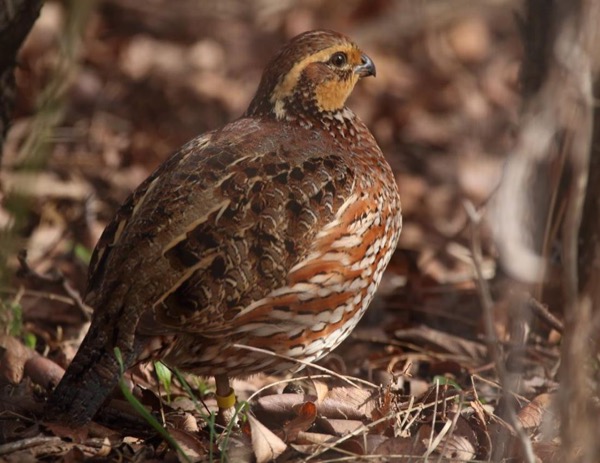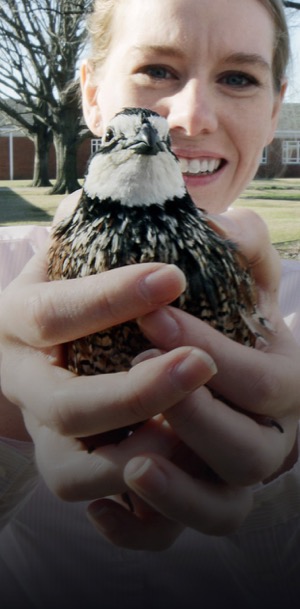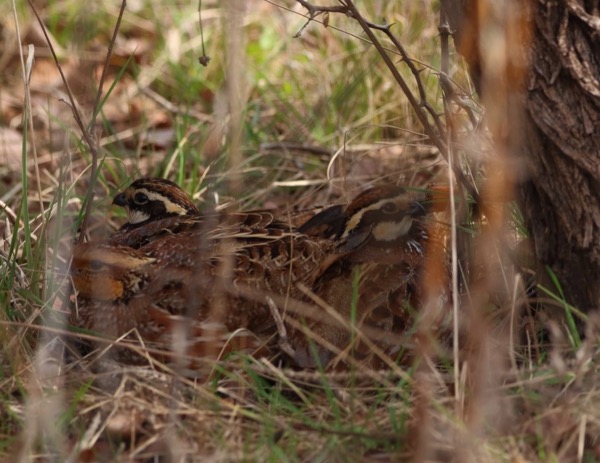North Texans unite to bring back quail
Quail awaiting release at Connemara Meadow in Allen. Photo by Chris Jackson, DFW Urban Wildllife.
By Amy Martin
March 23, 2020
The ascending whistle-like call of the bobwhite quail — poor bob WHITE – had for centuries been the essential high note of the rural symphony. The sound of quail, and their more slender cousins, mourning doves, was the gentle sunrise alarm as I lay sleeping in the screened-in porch at my grandmother’s country abode. It was the sound of contentedness.
The natty brown, barrel-chested, and short-tailed bobwhites possess a round head that ends in an abrupt beak. They poke along pigeon-step style on stout little legs, exploring the tangled grasses of prairies and pastures in search of seeds and small insects. Wary and elusive, at the slightest startle they fly up to the trees with a clatter.
Now those calls are seldom heard. Quail numbers declined by approximately 85 percent from 1966 to 2014. A crisis was apparent by 2008 when the decline continued despite better fire-ant control and long periods of favorable weather.
Thankfully, a group of North Texans are taking steps to bring back the iconic Texas birds. In January, they flocked to the North Texas Quail Restoration Workshop in McKinney to share best practices.
CALLING ALL QUAIL LOVERS
Connemara Meadow in Allen began working a few years ago on restoring quail to their 73 acres, as well as Lewisville Lake Environmental Learning Area.
Bob Mione, meadow manager of Connemara, felt more was needed and soon the idea for a North Texas Quail Restoration Workshop began to stir.
Learn about the bobwhite and other quail in this Texas Parks and Wildlife Department video.
“[Bob Mione] did most of the effort to make the workshop happen,” says Blackland Prairie Texas Master Naturalist Steve Their.
Held at the Heard Natural Science Museum and Wildlife Sanctuary in late January, the event attracted over 40 participants, with representatives from Collin County Open Space, Texas A&M AgriLife Extension and The Nature Conservancy, plus Cities of Allen, Fort Worth, Frisco, McKinney, and Plano park departments. Individual landowners and Audubon Society members also attended.
“We were pleased with the attendance,” said Their. “Our goal was to create a diverse community of quail experts such as Texas A&M AgriLife Research, nature organizations, municipalities, breeders and private landowners.”
The group created will emulate other quail preservation efforts such as Quail Forever, Park Cities Quail Coalition and Rolling Plains Quail Research Ranch, said Their.
Chase T. Brooke, an Texas A&M AgriLife Extension agent for Collin County, concurred:
“I think that the workshop was a great opportunity to put into perspective who all is currently working on quail restoration in North Texas, as well as to identify the components for successful reintroduction of quail in our area. Quail are a cornerstone bird species and working to restore them to our parks and natural areas in the DFW is a key component in maintaining our overall biodiversity.”
SPEAKING FROM EXPERIENCE
Together they pooled knowledge, resources and connections to explore solutions to habitat loss and fragmentation, improving existing quail habitat and minimizing threats from disease, parasites, predation and invasive animal, insect and plant species.

To reintroduce quail, chicks raised by professional breeders must be introduced to the property and raised to adulthood before release. Yet pen-raised quail mortality is far higher than wild quail.
Mione and his Connemara Meadow volunteers built a large pen for raising quail chicks. Two pairs of bobwhites released there nested, laid eggs, hatched eggs and began brooding the chicks. It was an exciting summer. And a sad fall.
“We did not have any significant rain in September or October,” said Mione. “We believe the bobwhite chicks did not survive to full adulthood.“
Predators are another challenge, which Mione tried to remediate with a call-back pen, where the birds can escape to safety at night. But the birds were reluctant to use it.
Dr. Ken Steigman, of Lewisville Lake Environmental Learning Area, spoke on their introduction of 100 quail chicks/adults. Working with UNT students under biology professors Jeff Johnson and Jim Bednarz, plus many from the Cross Timbers Chapter of Texas Master Naturalists, five groups of 20 birds were banded with unique colors and released in different areas of the refuge.
In mid-February, said Steigman they discovered about 14 bobwhite quail released last August on a prairie restoration site at LLELA.
“The birds had individuals from three different release groups, which means that these birds can find one another over time and regroup to form functional coveys after original groups suffer predation,” he said.
“These pen-raised birds survived six months in the wild, winter environmental conditions and appear to be very healthy,” continued Steigman. “They should be able to breed this spring and hopefully fledge our first F1 generation of bobwhites at LLELA.”
QUAIL BUSINESS

While LLELA and Connemara seek a return of quail for naturalist enjoyment, private landowners often have a different motivation. Quail are the third-most hunted game animal in Texas, making quail leases a profitable enterprise in cash-strapped rural counties.
Michael Baird, a veterinarian in DeKalb, spoke of his efforts as founder of the East Texas chapter of Quail Forever and administrator of the East Texas Wild Quail Restoration page on Facebook. Pamela Lynn of Sunset Ridge Ranch in Whitewright related her experience with breeding and brooding bobwhites.
Anchoring the workshop was Amanda Gobeli of Texas A&M Natural Resources Institute. She’s a major force in the Dallas-based Reversing the Quail Decline Initiative, which focuses on helping landowners increase quail populations. It’s a joint effort between Texas Parks and Wildlife Department and Texas A&M AgriLife Extension Service.
RQDI’s projects include QuailMasters classes on quail anatomy, ecology and habitat management. Quail Appreciation Days celebrate the bobwhite and other native species of quail – scaled or blue quail of West Texas; Gambel’s quail of the Trans Pecos; and the rare Montezuma quail of Big Bend. Every other year, RQDI presents a Statewide Quail Symposium.
“It was my pleasure to participate in the quail workshop at the Heard and to see how many people in the DFW area are passionate about quail,” said Gobeli.

THE RETURN OF THE QUAIL
The call — poor bob WHITE – once again wakes morning sleepers. Quail reintroductions have succeeded in states as diverse as Arizona, Minnesota and Tennessee. In a few places, bobwhite populations have begun to be self-sustaining.
“When we nurture wild spaces – even in urban areas – wild things will come to fill them.”
The workshop theme and key to successes was the primacy of habitat. Bobwhites require landscapes with native bunch grasses, forbs and woody shrubs arranged in a patchwork fashion, with dense woody cover for quail to escape predators.
Gobeli visited the Connemara prairie restoration before the workshop.
“The diversity of bird species I observed during my morning tour spoke to the impacts of their efforts,” said Gobeli. “When we nurture wild spaces – even in urban areas – wild things will come to fill them.”
Original post at: https://www.greensourcedfw.org/articles/north-texans-unite-bring-back-quail
Stay up to date on everything green in North Texas, including the latest news and events! Sign up for the weekly Green Source DFW Newsletter! Follow us on Facebook and Twitter. Also check out our new podcast The Texas Green Report, available on your favorite podcast app.





